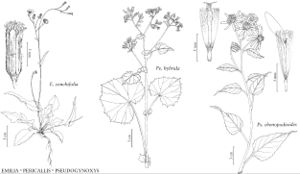Pericallis
in R. Sweet, Brit. Fl. Gard., ser. 2, 3: plate 228. 1834.
| Taxon | Illustrator ⠉ | |
|---|---|---|
 | Emilia sonchifolia Pericallis hybrida Pseudogynoxys chenopodioides | Linny Heagy Yevonn Wilson-Ramsey Yevonn Wilson-Ramsey |
Perennials [subshrubs or shrubs], mostly 20–40 (–100) [150+] cm. Stems usually 1, erect or spreading (branched distally). Leaves basal and cauline; alternate; petiolate (petiole bases sometimes expanded and/or clasping); blades palmately nerved, cordate-deltate to orbiculate or polygonally lobed, margins dentate to denticulate, faces sparsely hairy. Heads radiate, usually in corymbiform to paniculiform arrays, rarely borne singly. Calyculi 0. Involucres cylindric to urceolate, mostly 3–8+ mm diam. Phyllaries persistent, mostly 13 or 21 in (1–) 2 series, erect, distinct, ± linear, subequal, margins scarious (tips green to brown or reddish, not blackened). Receptacles flat, foveolate (socket margins membranous), epaleate. Ray-florets ± 13 or ± 21, pistillate, fertile; corollas whitish or bluish, pinkish, purplish, or reddish (often proximally pale and distally darker). Disc-florets 40–60+, bisexual, fertile; corollas ochroleucous, white, or purplish to reddish or pinkish, tubes longer than funnelform throats, lobes 5, erect or reflexed, deltate to lanceolate; style-branches stigmatic in 2 lines, apices truncate [with deltate appendages]. Cypselae ± ellipsoid (sometimes ± compressed), 4–5-ribbed, glabrous or puberulent; pappi readily falling, usually of 20–40+, white, barbellate bristles (discs), sometimes 2 setiform to subulate scales or 0 (rays). x = 30.
Distribution
Introduced; Macaronesia (Canary Islands), Macaronesia (Azores), Macaronesia (Madeira)
Discussion
Species ca. 15 (1 in the flora).
The taxonomic status and nomenclature of Pericallis have been treated by B. Nordenstam (1978); the origins of the florists’ cineraria have been reviewed by T. M. Barkley (1966).